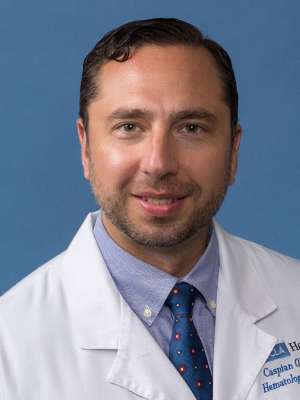- Center on Health Equity & Access
- Clinical
- Health Care Cost
- Health Care Delivery
- Insurance
- Policy
- Technology
- Value-Based Care
Reduced Rehospitalizations and Potential Cost Savings With Orca-T for Acute Leukemia, MDS: Caspian Oliai, MD, MS
Orca-T showed lower rates of graft-vs-host disease or infection compared with allogeneic hematopoietic stem cell transplantation for myelodysplastic syndrome (MDS) or acute leukemias in the Precision-T trial, Caspian Oliai, MD, MS, UCLA Bone Marrow Transplantation Stem Cell Processing Center, said.
For patients with myelodysplastic syndrome (MDS) or acute leukemias, allogeneic hematopoietic stem cell transplantation (allo-HSCT) is currently the only potentially curative therapeutic option. However, many patients—especially those who are older or more frail—may not be candidates for allo-HSCT due to potential adverse events, including chronic graft-vs-host disease (cGVHD).
In the phase 3 Precision-T trial (NCT05316701), an investigational allogeneic T-cell immunotherapy called Orca-T showed improved cGVHD-free survival vs allo-HSCT for MDS or acute leukemia, with findings presented at the 51st Annual Meeting of the European Society for Blood and Marrow Transplantation (EBMT). A positive trend in overall survival also emerged in the study.
Precision-T investigator Caspian Oliai, MD, MS, a medical oncologist and hematologist and medical director of the UCLA Bone Marrow Transplantation Stem Cell Processing Center, discussed trends in rehospitalization and the potential for cost savings with Orca-T compared with traditional allo-HSCT for acute leukemia and MDS in an interview with The American Journal of Managed Care® (AJMC®). In another interview, he discussed the Precision-T findings presented at the EBMT annual meeting.
This transcript has been lightly edited.
Caspian Oliai, MD, MS, UCLA Bone Marrow Transplantation Stem Cell Processing Center | Image credit: UCLA Health

AJMC: Are there data on the rates of hospitalization post treatment with Orca-T compared with traditional allo-HSCT?
Oliai: We have data with regard to rehospitalization between the 2 groups. In the phase 3 trial, the rehospitalization rate due to adverse events was lower with Orca-T—27% in the Orca-T group compared with 46% in the standard allogeneic transplant group. The reason why this is important is, if you think about the full costs associated with standard allogeneic transplant, they are not only based on the conditioning regimen and the cellular product that's being infused, the full costs also include the immunosuppressants that you subsequently take. Also, as you mentioned, the cost of hospitalizations in the setting of both severe infections and the cost of rehospitalizations in the setting of severe graft-vs-host disease.
As the data presented at the EBMT meeting have shown, the rate of severe infection and the rate of GVHD are lower with Orca-T, so that could potentially lower the costs that are associated with the full allogeneic transplant process when you're considering rehospitalization, that chunk of costs.
AJMC: Many patients require treatment for GVHD after allo-HSCT. Are cost savings anticipated if the traditional post–allo-HSCT treatment is avoided?
Oliai: For sure, on the surface and overall. If the patient doesn't develop GVHD, they're not going to need those treatments for acute and chronic GVHD that you're referring to. Some of them are very expensive medications like ruxolitinib, some of them are expensive intravenous infusions like axatilimab, that was recently FDA approved. If we can avoid having patients require those, that's the best way to cut down on costs for sure.
AJMC: Describe the challenges that clinicians face today in deciding whether a patient is a candidate for conventional allo-HSCT.
Oliai: In regard to candidacy for allo-HSCT, the main question that we use to approach these cases, especially in older patients, is, “Can the patient tolerate the combination of intensive conditioning and also the subsequent intensive immunosuppression that is necessary to achieve a cure from the specific hematologic malignancy?” Now, many older patients can't tolerate this combination of intensive conditioning with immunosuppression at a high level. That, unfortunately, makes them ineligible for what is really the only curative strategy for most acute leukemias and MDS.
With Orca-T, as we're seeing, the strategy is safer. There are lower rates of GVHD, there are lower rates of infection, and the reason why is because there's less immunosuppression post Orca-T using only single-agent tacrolimus prophylaxis. Perhaps that can make more older patients eligible for this curative strategy for their hematologic malignancy.
Reference
Meyer EH, Salhotra A, Gandhi AP, et al. OS15-01 Orca-T demonstrates improved survival free of chronic GVHD compared to conventional allogeneic hematopoietic stem cell transplant: a randomized phase 3 trial in advanced hematologic malignancies. Presented at: 51st Annual Meeting of the EBMT; March 30-April 2, 2025; Florence, Italy. Oral session 15-01. https://ebmt2025.abstractserver.com/program/#/details/presentations/989
Zanubrutinib Shows Similar Efficacy but Better Safety Than VEN–I in Frontline CLL
November 26th 2025The analysis found that zanubrutinib provides similar progression-free survival to fixed-duration venetoclax plus ibrutinib but with consistently fewer serious side effects, suggesting a more favorable overall safety profile.
Read More
